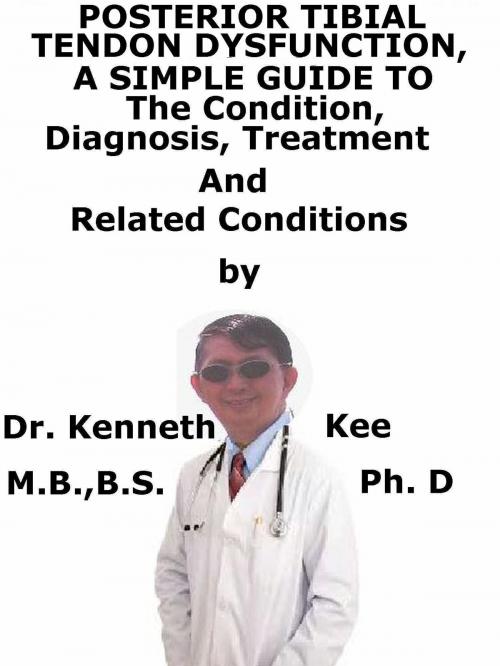Posterior Tibial Tendon Dysfunction, A Simple Guide To The Condition, Diagnosis, Treatment And Related Conditions
Nonfiction, Health & Well Being, Health, Ailments & Diseases, Musculoskeletal, Medical, Specialties, Orthopedics| Author: | Kenneth Kee | ISBN: | 9781370984411 |
| Publisher: | Kenneth Kee | Publication: | March 18, 2017 |
| Imprint: | Smashwords Edition | Language: | English |
| Author: | Kenneth Kee |
| ISBN: | 9781370984411 |
| Publisher: | Kenneth Kee |
| Publication: | March 18, 2017 |
| Imprint: | Smashwords Edition |
| Language: | English |
Posterior tibial tendon dysfunction (PTTD) is a medical disorder that results in inflammation or tearing of the posterior tibial tendon.
The posterior tibial tendon attaches one of the calf muscles to the bones located on the inner foot.
Consequently, PTTD causes flatfoot because the tendon is not able to support the arch of the foot.
Flatfoot is when the arch of the foot is fallen and the foot points outwards.
PTTD is also called adult acquired flatfoot as opposed to congenital flat foot.
Doctors can normally treat this disorder without surgery, but sometimes surgery is essential to mend the tendon.
Incidence
Posterior tibial tendon dysfunction (PTTD) is more frequent in women.
It often manifests in the sixth decade.
Mechanism:
The exact cause of PTTD is not known.
It is an acute injury (e.g., ankle fractures caused by pronation and external rotation vs. long-standing tendon degeneration)
1. Early disease
Early tenosynovitis continues to PTTD
It results in loss of medial longitudinal arch dynamic stabilization
2. Late disease
PTTD supplies attritional failure of static hind-foot stabilizers and collapse of the medial longitudinal arch
1. Spring ligament complex (e.g., superomedial calcaneonavicular ligament)
2. Plantar fascia
3. Plantar ligaments
Fixed degenerative joint changes happen at late stages
1. Foot deformity
2. Pes planus
3. Hind foot valgus
4. Forefoot varus
5. Forefoot abduction
Risk factors are:
1. Obesity
2. Hypertension
3. Diabetes
4. Increased age
5. Corticosteroid use
6. Seronegative inflammatory disorders
Frequent activities that induce an overuse injury are:
1. Walking
2. Running
3. Hiking
4. Climbing stairs
5. High-impact sports
PTTD tends more to happen in:
1. Females
2. People over the age of 40
3. People who are overweight or obese
4. Diabetics
5. People with hypertension
Symptoms of PTTD are:
1. Pain, normally around the inside of the foot and ankle
2. Swelling, warmth, and redness along the inside of the foot and ankle
3. Pain that worsens during activity
4. Flattening of the foot
5. Inward rolling of the ankle
6. Turning out of the toes and foot
Physical examination is by inspection and palpation of the foot
1. Pes planus or flat foot is evident
2. Collapse of the medial longitudinal arch is present
3. Hind foot valgus deformity is seen
4. Forefoot abduction is seen in Stage IIB disease
5. The "Too many toes" sign is present
6. >40% talonavicular uncoverage
7. Forefoot varus
The doctor may look for swelling along the posterior tibial tendon.
The doctor will also assess the range of motion by moving the foot side to side and up and down.
PTTD can provide problems with side-to-side range of motion, and issues with moving the toes toward the shinbone.
The doctor will also observe the shape of the foot.
They will examine for a collapsed arch and a heel that has shifted outward.
The doctor may also assess how many toes they can see from behind the heel when the patient is standing.
Normally, only the fifth toe and half of the fourth toe are seen from this angle.
MRI and ultrasound scans can verify PTTD
Most cases of PTTD are treatable without surgery.
1. Reducing Swelling and Pain
Early treatment helps decrease pain and swelling and permits the tendon to heel.
Applying ice to the sore area and taking non-steroidal anti-inflammatory medications (NSAIDs) can decrease swelling and pain.
The doctor will also advise the patient to rest and avoid activities
2. Foot Support
Dependent on the seriousness of the PTTD, the doctor may indicate some form of support for the foot and ankle.
Surgery may be required if the PTTD is serious.
FDL transfer
Calcaneal osteotomy
Arthrodesis
TABLE OF CONTENT
Chapter 1 Posterior Tibial Tendon Dysfunction
Chapter 2 Causes
Chapter 3 Symptoms
Chapter 4 Diagnosis
Chapter 5 Treatment
Chapter 6 Prognosis
Chapter 7 Flat Feet
Chapter 8 Tarsal Tunnel Syndrome
Epilogue
Posterior tibial tendon dysfunction (PTTD) is a medical disorder that results in inflammation or tearing of the posterior tibial tendon.
The posterior tibial tendon attaches one of the calf muscles to the bones located on the inner foot.
Consequently, PTTD causes flatfoot because the tendon is not able to support the arch of the foot.
Flatfoot is when the arch of the foot is fallen and the foot points outwards.
PTTD is also called adult acquired flatfoot as opposed to congenital flat foot.
Doctors can normally treat this disorder without surgery, but sometimes surgery is essential to mend the tendon.
Incidence
Posterior tibial tendon dysfunction (PTTD) is more frequent in women.
It often manifests in the sixth decade.
Mechanism:
The exact cause of PTTD is not known.
It is an acute injury (e.g., ankle fractures caused by pronation and external rotation vs. long-standing tendon degeneration)
1. Early disease
Early tenosynovitis continues to PTTD
It results in loss of medial longitudinal arch dynamic stabilization
2. Late disease
PTTD supplies attritional failure of static hind-foot stabilizers and collapse of the medial longitudinal arch
1. Spring ligament complex (e.g., superomedial calcaneonavicular ligament)
2. Plantar fascia
3. Plantar ligaments
Fixed degenerative joint changes happen at late stages
1. Foot deformity
2. Pes planus
3. Hind foot valgus
4. Forefoot varus
5. Forefoot abduction
Risk factors are:
1. Obesity
2. Hypertension
3. Diabetes
4. Increased age
5. Corticosteroid use
6. Seronegative inflammatory disorders
Frequent activities that induce an overuse injury are:
1. Walking
2. Running
3. Hiking
4. Climbing stairs
5. High-impact sports
PTTD tends more to happen in:
1. Females
2. People over the age of 40
3. People who are overweight or obese
4. Diabetics
5. People with hypertension
Symptoms of PTTD are:
1. Pain, normally around the inside of the foot and ankle
2. Swelling, warmth, and redness along the inside of the foot and ankle
3. Pain that worsens during activity
4. Flattening of the foot
5. Inward rolling of the ankle
6. Turning out of the toes and foot
Physical examination is by inspection and palpation of the foot
1. Pes planus or flat foot is evident
2. Collapse of the medial longitudinal arch is present
3. Hind foot valgus deformity is seen
4. Forefoot abduction is seen in Stage IIB disease
5. The "Too many toes" sign is present
6. >40% talonavicular uncoverage
7. Forefoot varus
The doctor may look for swelling along the posterior tibial tendon.
The doctor will also assess the range of motion by moving the foot side to side and up and down.
PTTD can provide problems with side-to-side range of motion, and issues with moving the toes toward the shinbone.
The doctor will also observe the shape of the foot.
They will examine for a collapsed arch and a heel that has shifted outward.
The doctor may also assess how many toes they can see from behind the heel when the patient is standing.
Normally, only the fifth toe and half of the fourth toe are seen from this angle.
MRI and ultrasound scans can verify PTTD
Most cases of PTTD are treatable without surgery.
1. Reducing Swelling and Pain
Early treatment helps decrease pain and swelling and permits the tendon to heel.
Applying ice to the sore area and taking non-steroidal anti-inflammatory medications (NSAIDs) can decrease swelling and pain.
The doctor will also advise the patient to rest and avoid activities
2. Foot Support
Dependent on the seriousness of the PTTD, the doctor may indicate some form of support for the foot and ankle.
Surgery may be required if the PTTD is serious.
FDL transfer
Calcaneal osteotomy
Arthrodesis
TABLE OF CONTENT
Chapter 1 Posterior Tibial Tendon Dysfunction
Chapter 2 Causes
Chapter 3 Symptoms
Chapter 4 Diagnosis
Chapter 5 Treatment
Chapter 6 Prognosis
Chapter 7 Flat Feet
Chapter 8 Tarsal Tunnel Syndrome
Epilogue















